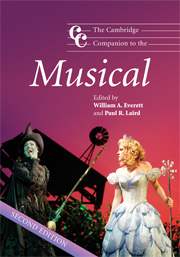Book contents
- Frontmatter
- Part I Adaptations and transformations: before 1940
- Part II Maturations and formulations: 1940–1970
- Part III Evolutions and integrations: after 1970
- 11 Stephen Sondheim and the musical of the outsider
- 12 Choreographers, directors and the fully integrated musical
- 13 From Hair to Rent: is ‘rock’ a four-letter word on Broadway?
- 14 The megamusical: the creation, internationalisation and impact of a genre
- 15 ‘Something borrowed, something blue’: the marriage of the musical and Europe
- 16 New horizons: the musical at the dawn of the twenty-first century
- Part IV Legacies and transformations
- Notes
- Select bibliography
- Index
14 - The megamusical: the creation, internationalisation and impact of a genre
from Part III - Evolutions and integrations: after 1970
Published online by Cambridge University Press: 28 September 2011
- Frontmatter
- Part I Adaptations and transformations: before 1940
- Part II Maturations and formulations: 1940–1970
- Part III Evolutions and integrations: after 1970
- 11 Stephen Sondheim and the musical of the outsider
- 12 Choreographers, directors and the fully integrated musical
- 13 From Hair to Rent: is ‘rock’ a four-letter word on Broadway?
- 14 The megamusical: the creation, internationalisation and impact of a genre
- 15 ‘Something borrowed, something blue’: the marriage of the musical and Europe
- 16 New horizons: the musical at the dawn of the twenty-first century
- Part IV Legacies and transformations
- Notes
- Select bibliography
- Index
Summary
Nowhere in the realm of the musical theatre is technology more evident than in the world of the megamusical. These ‘larger than life’ visual and aural spectacles dazzle audiences and are among the most popular musical theatre works at the beginning of the twenty-first century. Les Misérables, billed as ‘the world's most popular musical’, and Cats, heralded as ‘now and forever’, are but two shows where commercial slogans enlist, endorse and promote the genre's mass appeal.
But what exactly are megamusicals? Terms such as ‘through-composed popular operas’ and ‘poperas’ have also been used to describe the phenomenon of sung-through musicals where set design, choreography and special effects are at least as important as the music. They are overtly romantic and sentimental in nature, meant to create strong emotional reactions from the audience. Stories merge aspects of human suffering and redemption with matters of social consciousness.
Aspects of the megamusical demonstrate a reinvigoration of nineteenth-century French grand opera. Whereas audiences in the late twentieth century were dazzled by stage effects such as the chandelier and underground lake in The Phantom of the Opera, the staircase in Sunset Boulevard, the barricade in Les Misérables and the helicopter in Miss Saigon, their nineteenth-century French counterparts saw the eruption of Vesuvius in Daniel-François-Esprit Auber's La muette de Portici (1828) and the St Bartholomew's Day Massacre in Giacomo Meyerbeer's Les Huguenots (1836).
- Type
- Chapter
- Information
- The Cambridge Companion to the Musical , pp. 250 - 269Publisher: Cambridge University PressPrint publication year: 2008
- 3
- Cited by

